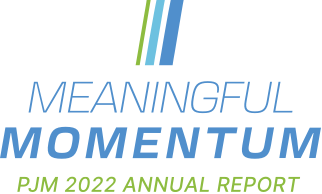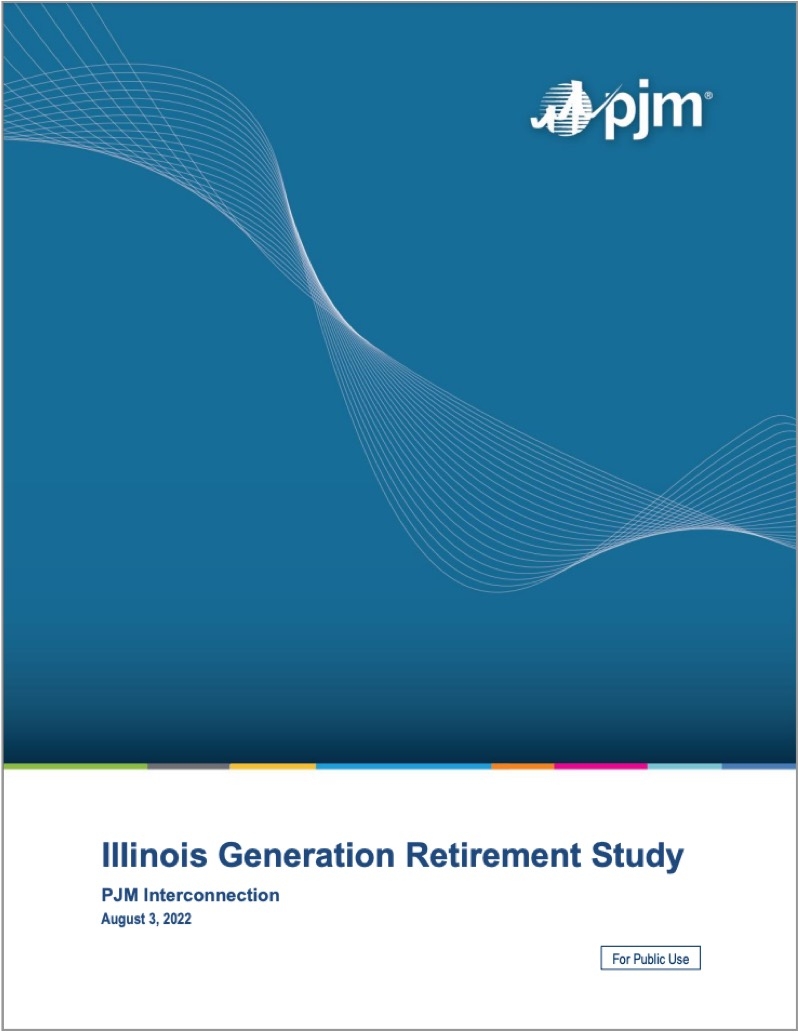



Grid of the
Future

Preparing for a future grid featuring more dispersed and smaller renewable resources was at the heart of PJM’s planning efforts in 2022.
PJM leveraged its planning expertise to analyze the needs of the changing grid while informing stakeholders, members, regulators and policymakers about the resource adequacy requirements of the bulk electric system.
These preparations are critical for PJM to help states advance their decarbonization policy goals while maintaining reliability.
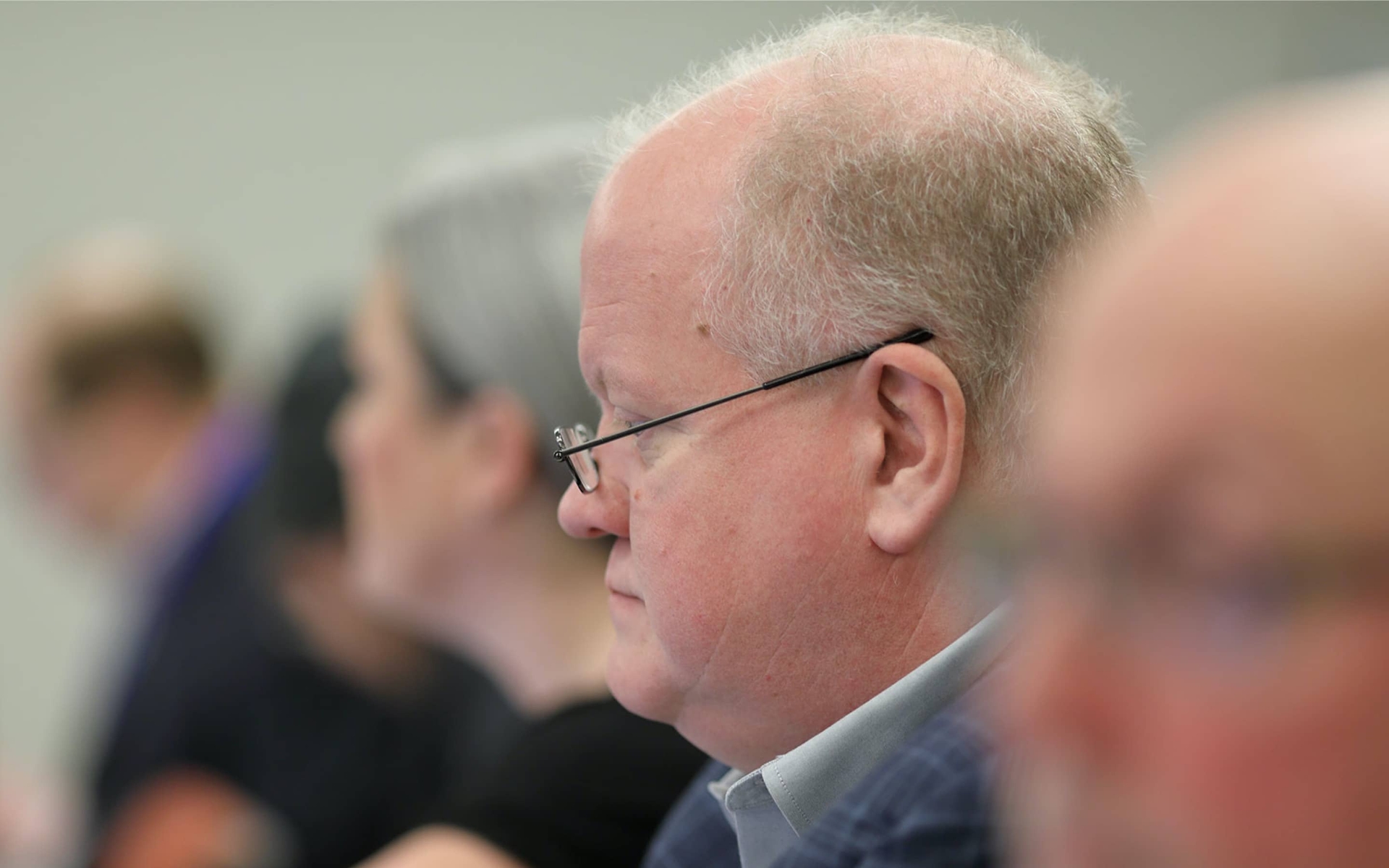
Interconnection
Process Reform
PJM and stakeholders passed a significant milestone in November when FERC approved a more efficient and timely process to handle New Service Requests.
Designed to clear the backlog of generation resources seeking to connect to the grid and establish a new process in line with industry needs, PJM’s reformed interconnection process will move the process from a “first-come, first-served” model to a “first-ready, first-served” cycle approach.
It will move requests through the interconnection queue more efficiently...
weed out speculative projects...
and focus on projects that are more likely to be built.
During the transition period – expected to begin in the first half of 2023 – PJM will prioritize
1,200+ projects
most of them renewables, representing
100,000 MW of nameplate capacity.
In April 2022, members overwhelmingly endorsed the plan.
The goal is to have the backlog cleared and new projects reviewed under new rules by 2026.
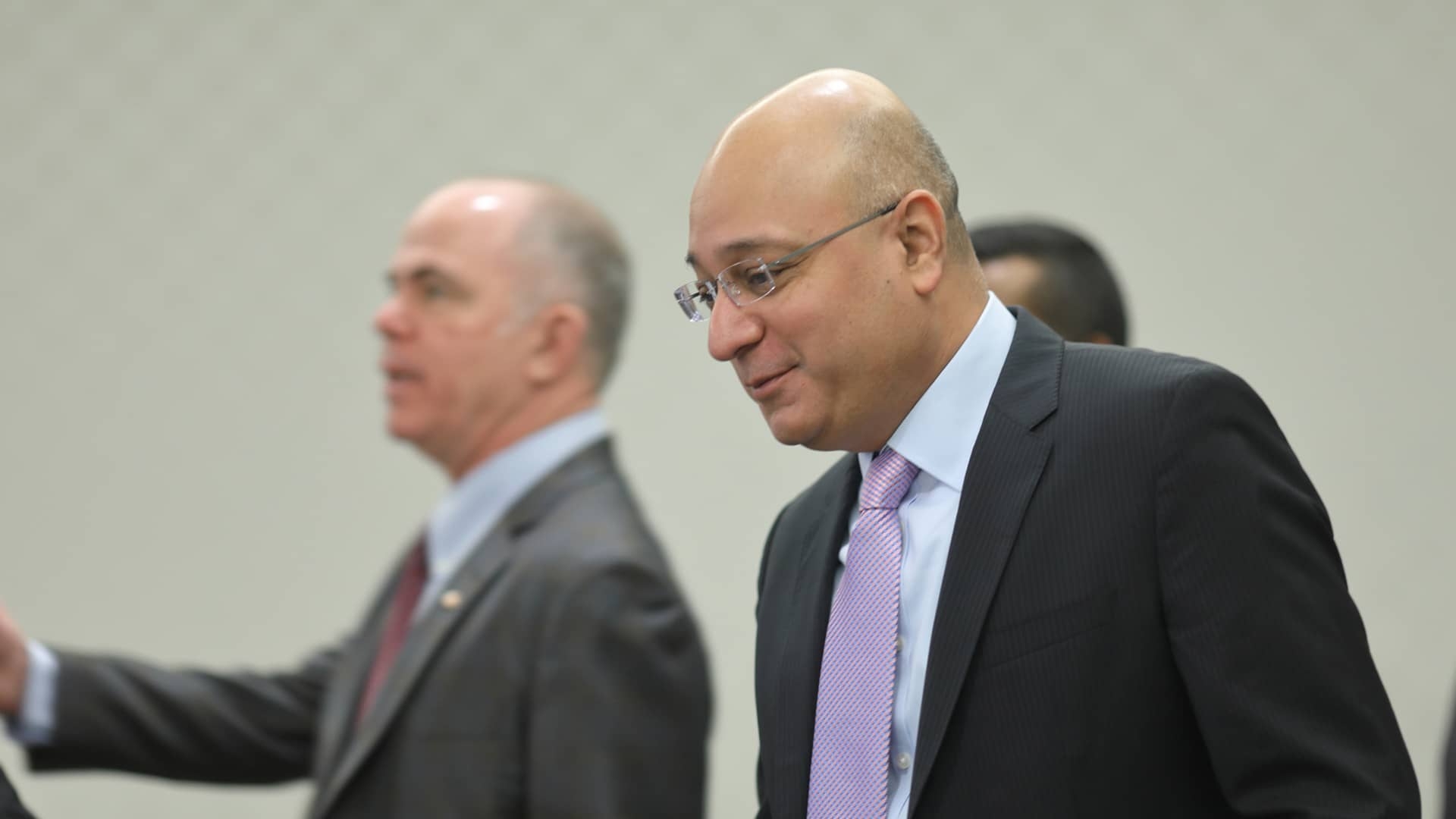
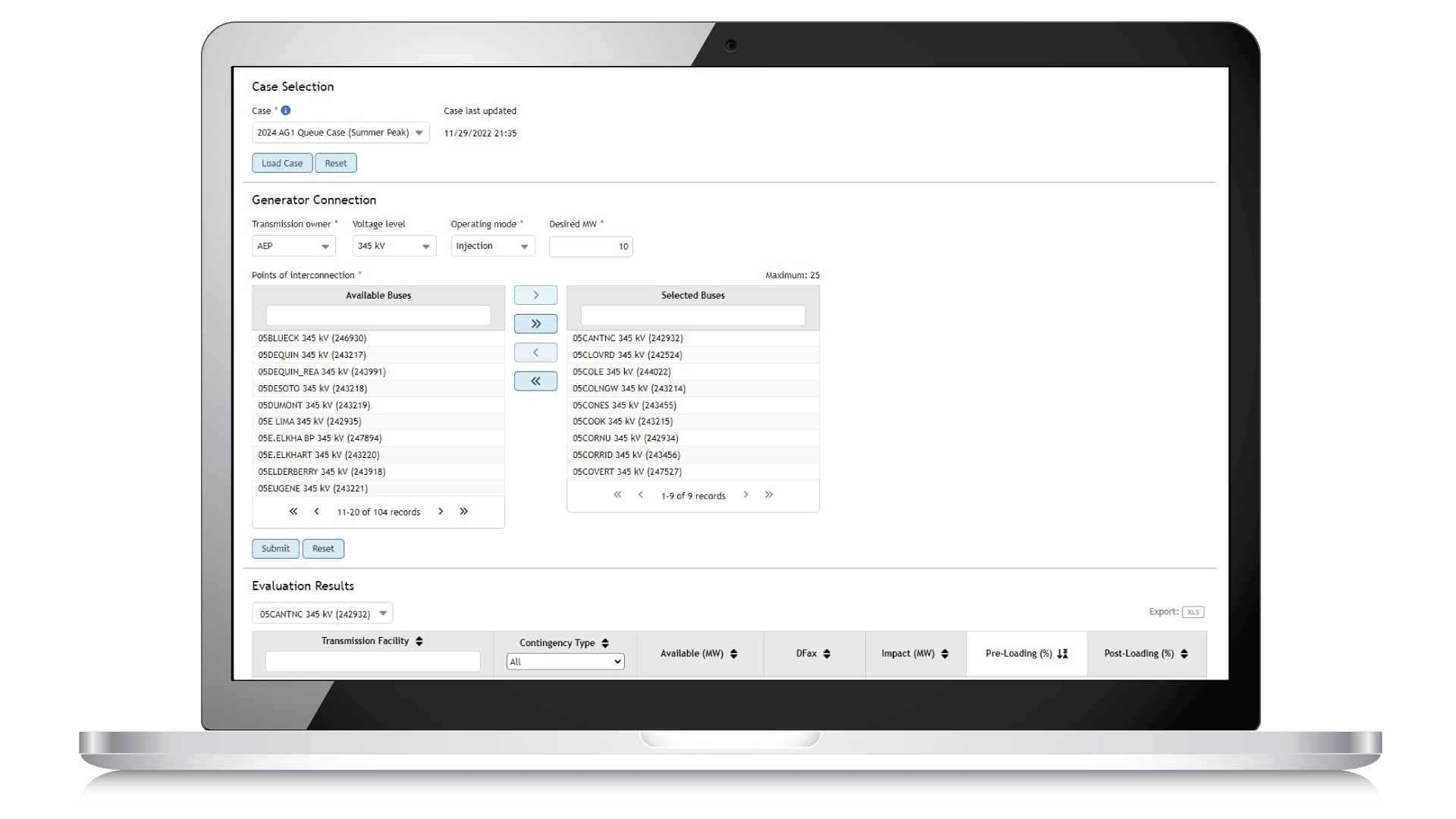
Queue
Scope
In 2022, PJM launched a new, publicly accessible tool to help generators seeking to enter the interconnection queue.
Queue Scope allows prospective generation developers or other users to assess the location of future generators before they formally enter PJM’s interconnection queue.
Using PJM’s Regional Transmission Expansion Plan (RTEP) and interconnection queue studies, the tool analyzes the impacts on the PJM system based on the amount of megawatts that would be added to the system at a chosen point of interconnection.
Queue Scope is designed to allow developers to better assess the viability of their potential projects before entering PJM’s interconnection process.
The public version of Queue Scope can also be accessed without a PJM.com account, allowing any user to see the potential impacts of adding generation to the system.
The initial launch of Queue Scope is limited to a tabular format. However, PJM plans to launch a version of the tool that utilizes the PJM system map in 2023.
PJM partners with
New Jersey on
Offshore
Wind Goals
In 2022, PJM realized the culmination of its groundbreaking application of the State Agreement Approach (SAA) with the New Jersey Board of Public Utilities (NJBPU). The SAA enables a state or group of states to propose a project that could potentially support public policy requirements as long as the state (or states) agrees to pay all costs of the state-selected buildout included in the RTEP.
On Oct. 26, NJBPU selected a package of onshore transmission solutions that, in conjunction with prior action, will enable the injection of
7,500 MW of offshore
wind capacity by 2035
The NJBPU order was informed by technical analysis performed by PJM staff under the SAA, through which states can access PJM’s expertise and existing planning process to cost-effectively develop and optimize the transmission improvements necessary to support the reliable interconnection of certain desirable resources.
PJM assisted the NJBPU in analyzing
80 proposals submitted by
13 developers
through PJM’s competitive planning process.
The SAA provision was incorporated into PJM’s Operating Agreement in 2014 as part of the implementation of FERC Order 1000, but New Jersey is the first jurisdiction in the PJM region to request it be used to further its renewable energy goals.
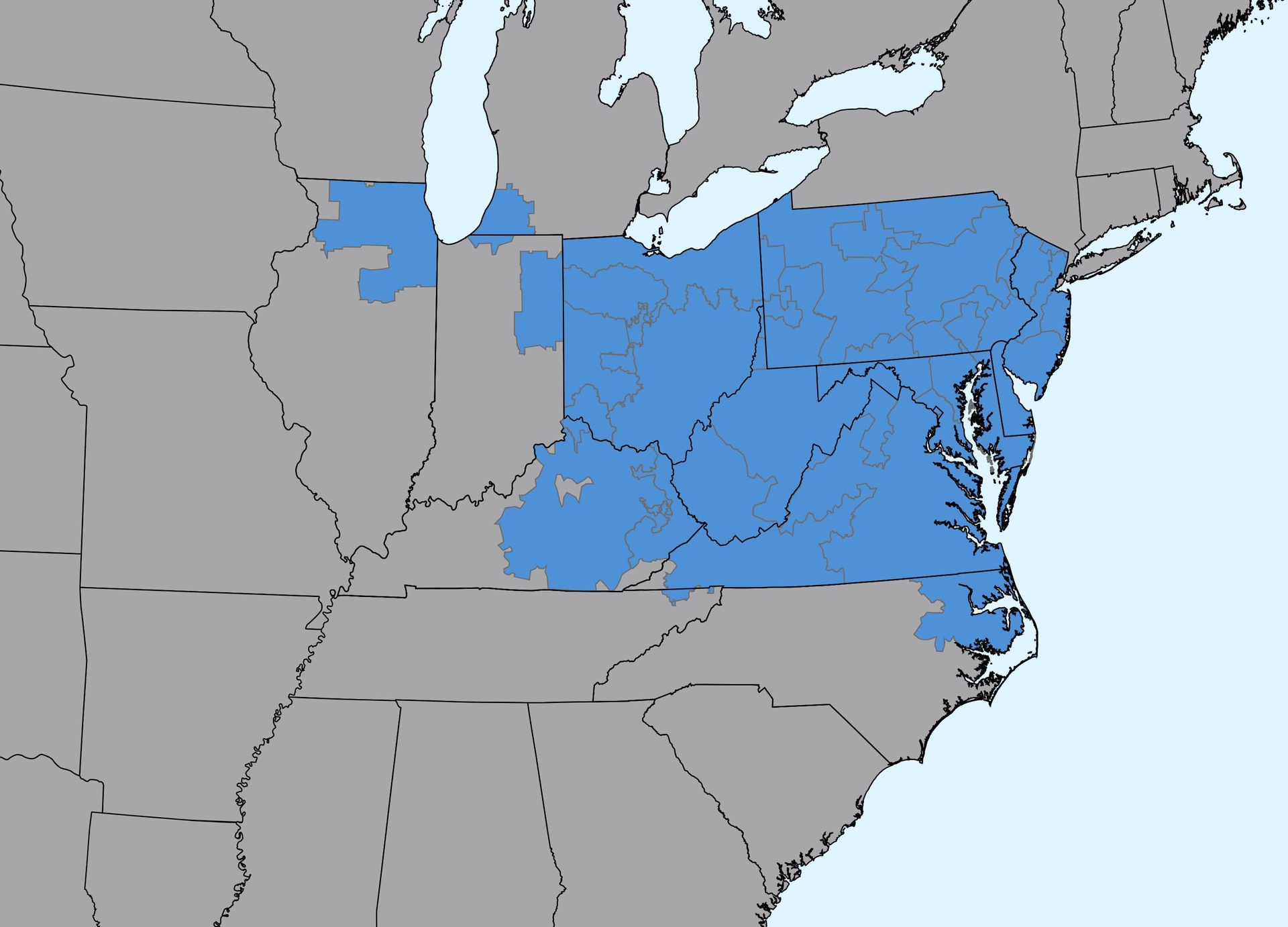

Long-term load forecast adopts
Hourly Model
PJM’s long-term load forecast estimates electricity demand across the PJM region up to 15 years in advance. In 2022, PJM instituted key improvements to modeling and forecast inputs and processes to improve accuracy.
For example, for the long-term load forecast process released in late 2022, PJM used an hourly model rather than a daily model. This enabled PJM to better model the impacts of solar Behind the Meter Generation and Energy Storage Resources.
Forecast Highlights
PJM's long-term load forecast predicts estimated load growth of
0.8%
per year for summer peaks
1%
for winter peaks
1.4%
for net energy over a 10-year planning horizon
Starting in 2023
Forecast Highlights
In a key change, PJM used monthly rather than annual economic and other government and private data to model residential, commercial
and industrial sectors.
Forecast Highlights
The long-term load forecast accounts for possible growth of electric vehicles in the PJM footprint.
500,000
IN 2022
Up to
5,000,000
IN 2038
Furthering long-term
Transmission Planning
In its focus on long-term transmission planning, PJM was in step with growing interest by FERC, which issued the following four related Notices of Proposed Rulemaking (NOPR):
- Building for the Future Through Electric Regional Transmission Planning and Cost Allocation and Generator Interconnection (also called the Long-Term Planning NOPR)
- Transmission System Planning Performance Requirements for Extreme Weather
- One-Time Informational Reports on Extreme Weather Vulnerability Assessments, Climate Change, Extreme Weather and Electric System Reliability
- Improvements to Generator Interconnection Procedures and Agreements
In February, PJM kicked off a series of Long-Term Transmission Planning Reform Workshops to engage stakeholders on potential reforms. PJM filed its comments on FERC’s Long-Term Planning NOPR in August after significant feedback from stakeholders, state regulators and staff.
PJM executives also were busy providing testimony on the issue, including Ken Seiler, Vice President – Planning. Among his appearances, he joined FERC’s Oct. 6 Technical Conference on Transmission Planning and Cost Management, where he detailed how PJM evaluates, selects and develops regional transmission facilities.

Illinois climate and equitable jobs act
Reliability Guidance
and study
PJM assists state policymakers with technical and planning expertise to further policy goals. In 2022, PJM expanded outreach and coordination with states to support reliability amid the evolving resource mix.
PJM Studies inform the
Energy transition
In May, PJM released the second phase of its ongoing study to explore potential system impacts of the evolving resource mix, including the accelerating integration of renewables.
Five key focus areas
Energy Transition in PJM: Emerging Characteristics of a Decarbonizing Grid suggests five key focus areas for PJM and its stakeholders and informs subsequent phases of the study, outlined in the following findings:
Electrification
retail rate design
Market reforms
Renewable resources
Energy Storage
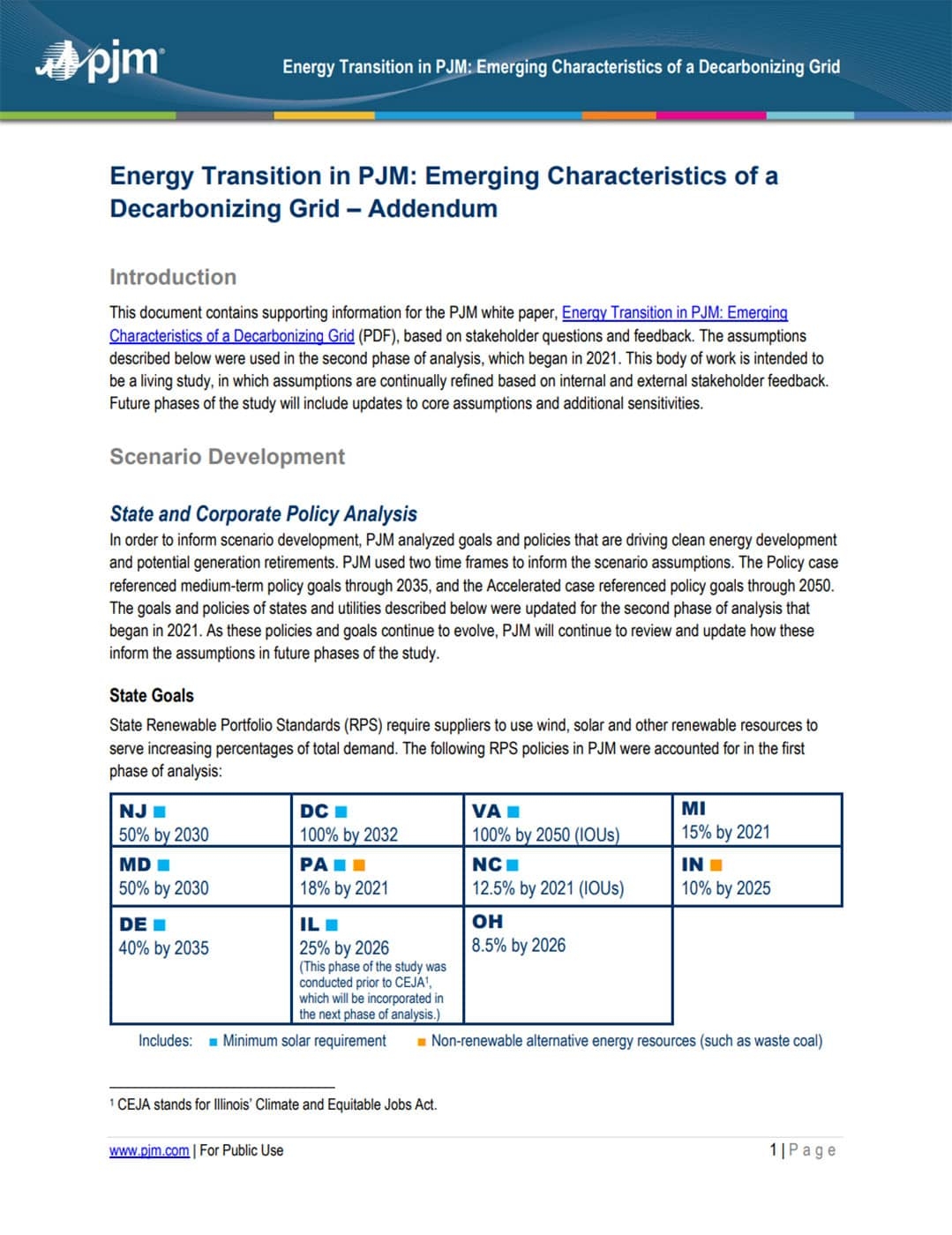
In October 2022, PJM published an addendum to the study, developed in response to stakeholder questions and feedback.
DOWNLOAD the pdf
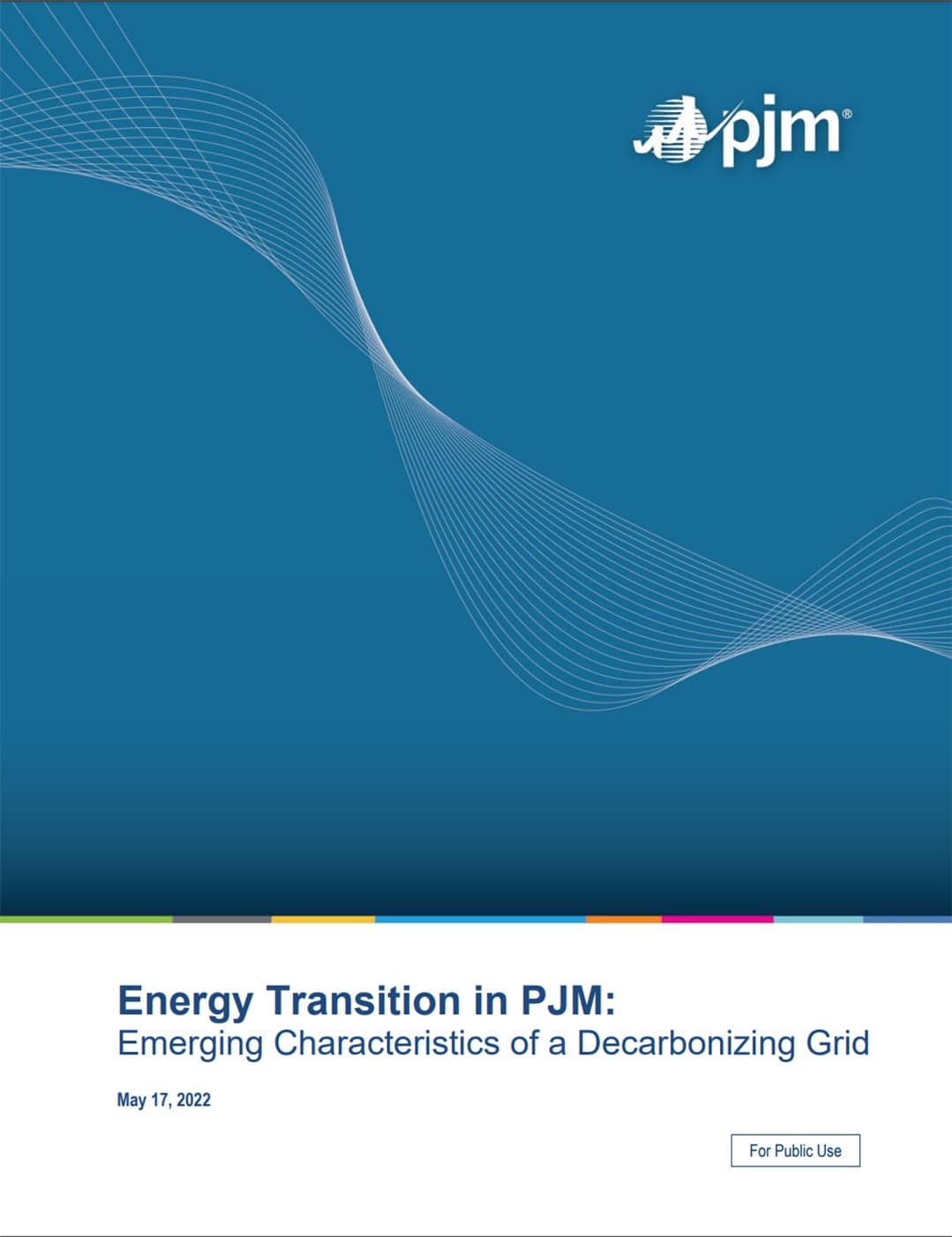
Also in 2022, PJM released a report outlining a vision for the grid of the future informed by examining how key industry trends and drivers could impact PJM and its transmission planning process.
DOWNLOAD Report
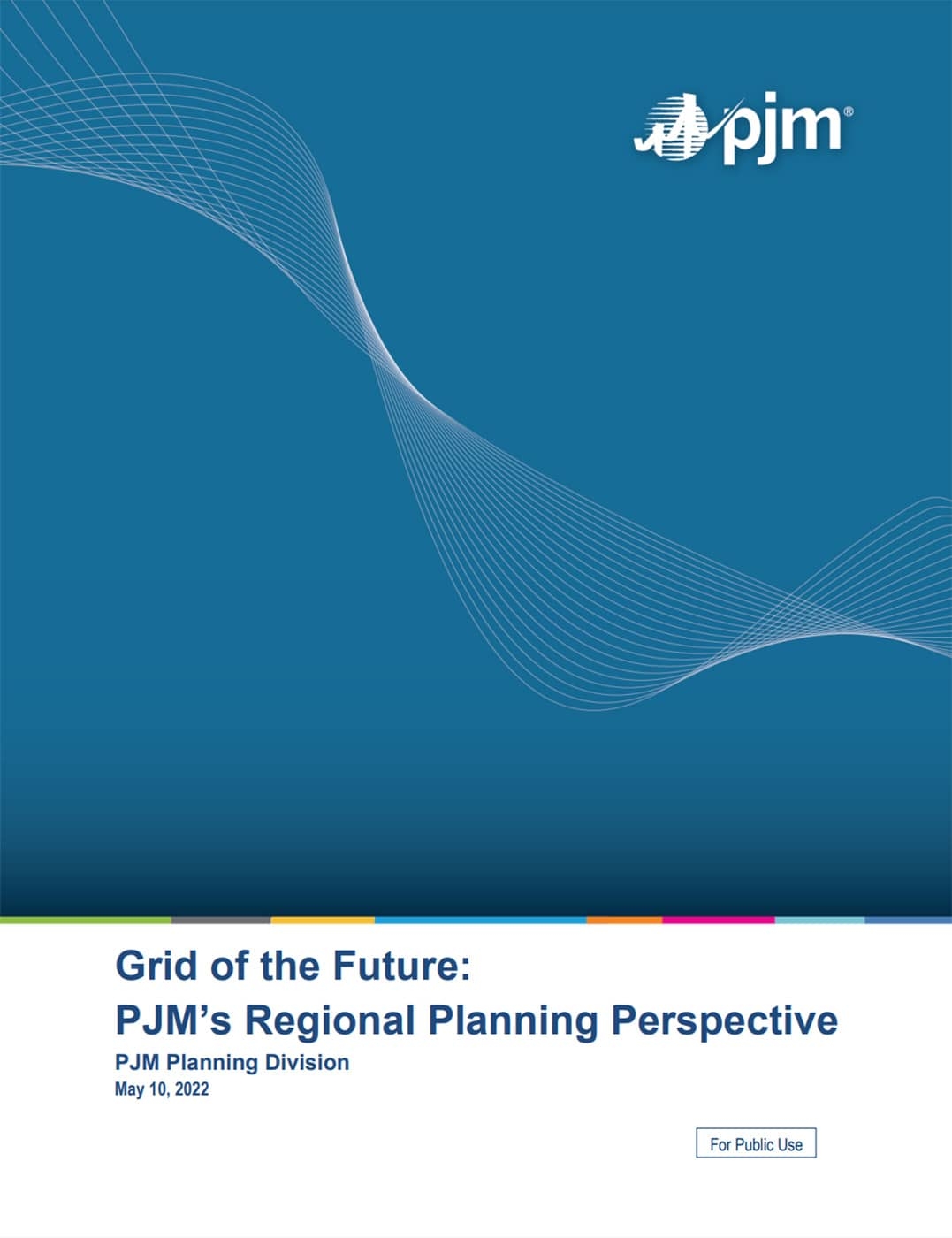
Grid of the Future: PJM’s Regional Planning Perspective
envisions a transmission system driven by decarbonizaton, renewables, public policy, a diverse resource mix and new technologies.
DOWNLOAD the pdf
PJM Leadership
perspectives
As the resource-neutral, FERC-designated grid operator of the largest bulk electric system in the U.S., PJM offers perspectives on operations, planning, and markets, and implications for the evolving system to the energy industry, stakeholders, policymakers and other entities.
PJM President & CEO Manu Asthana was appointed to the President’s National Infrastructure Advisory Council. The NIAC advises the White House on how to reduce physical and cyber risks and improve the security and resilience of the nation’s critical infrastructure sectors.
Since its establishment in 2001, the National Infrastructure Advisory Council (NIAC) has addressed issues including: improving intelligence information-sharing across government and industry; identifying and reducing complex cyber risks; and better preparing for and responding to disruptions that can ripple across multiple infrastructure systems.
It is the only executive council that examines critical infrastructure security and resilience and provides recommendations to the President.
The Chamber of Commerce for Greater Philadelphia appointed Asthana to its executive committee. Asthana’s appointment in October to the 32-member executive committee of the Chamber of Commerce continues his service on the organization’s board of directors, which began in 2020.
Stu Bresler III, Senior Vice President – Market Services, was appointed to the U.S. Department of Energy’s Nuclear Energy Advisory Committee (NEAC).
The NEAC functions under the Office of Nuclear Energy and plays a role in advising on issues, plans and priorities related to the agency’s nuclear programs.
Bresler joins 10 additional nuclear science, business, academic and energy industry leaders as members of the committee.
Ken Seiler, Vice President – Planning, was appointed to the ReliabilityFirst board of directors where he represents the Regional Transmission Organization (RTO) Industry Sector, a board position that rotates to a different RTO each term to ensure active and equal RTO representation and guidance.
ReliabilityFirst’s mission is to ensure that the electric grid is reliable and secure – not only for today but also for tomorrow.
Darlene Phillips, Executive Director – Operations Engineering Support, was reappointed to the U.S. Department of Energy’s Electricity Advisory Committee (EAC).
The EAC advises federal energy policymakers and regulators on grid resilience, security and reliability, and helps identify emerging issues and makes recommendations.
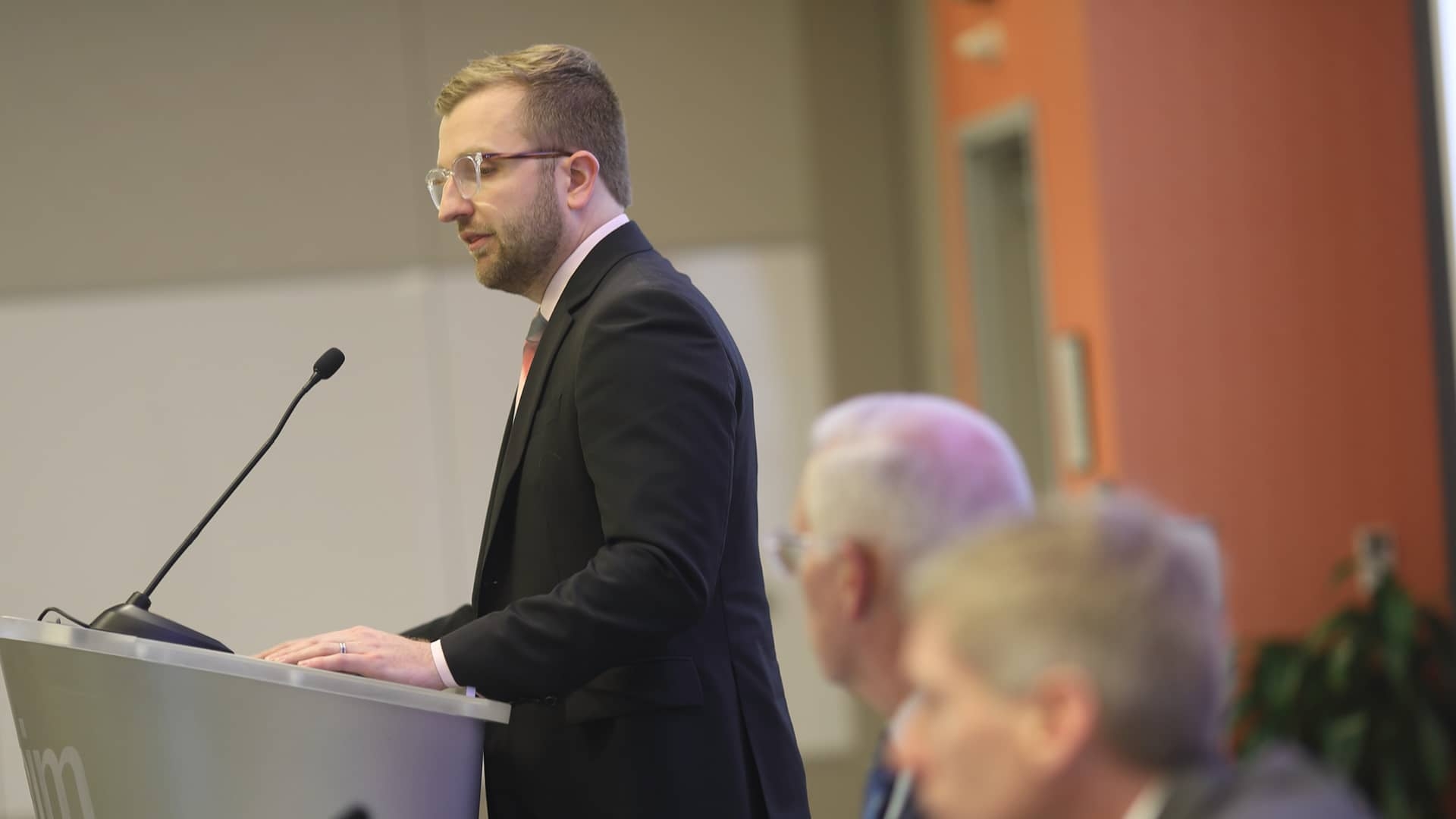
Grid of the
Future

Preparing for a future grid featuring more dispersed and smaller renewable resources was at the heart of PJM’s planning efforts in 2022.
PJM leveraged its planning expertise to analyze the needs of the changing grid while informing stakeholders, members, regulators and policymakers about the resource adequacy requirements of the bulk electric system.
These preparations are critical for PJM to help states advance their decarbonization policy goals while maintaining reliability.
Interconnection
Process Reform
PJM and stakeholders passed a significant milestone in November when FERC approved a more efficient and timely process to handle New Service Requests.
Designed to clear the backlog of generation resources seeking to connect to the grid and establish a new process in line with industry needs, PJM’s reformed interconnection process will move the process from a “first-come, first-served” model to a “first-ready, first-served” cycle approach.
During the transition period – expected to begin in the first half of 2023 – PJM will prioritize
1,200+ projects
most of them renewables, representing 100,000 MW of nameplate capacity.
PJM and stakeholders collaborated for more than a year to develop a proposal to
In April 2022, members overwhelmingly endorsed the plan.
The goal is to have the backlog cleared and new projects reviewed under new rules by 2026.


Queue Scope
In 2022, PJM launched a new, publicly accessible tool to help generators seeking to enter the interconnection queue.
Queue Scope allows prospective generation developers or other users to assess the location of future generators before they formally enter PJM’s interconnection queue.
Using PJM’s Regional Transmission Expansion Plan (RTEP) and interconnection queue studies, the tool analyzes the impacts on the PJM system based on the amount of megawatts that would be added to the system at a chosen point of interconnection.
Queue Scope is designed to allow developers to better assess the viability of their potential projects before entering PJM’s interconnection process.
The public version of Queue Scope can also be accessed without a PJM.com account, allowing any user to see the potential impacts of adding generation to the system.
The initial launch of Queue Scope is limited to a tabular format. However, PJM plans to launch a version of the tool that utilizes the PJM system map in 2023.
PJM partners with
New Jersey on
Offshore
Wind Goals
In 2022, PJM realized the culmination of its groundbreaking application of the State Agreement Approach (SAA) with the New Jersey Board of Public Utilities (NJBPU). The SAA enables a state or group of states to propose a project that could potentially support public policy requirements as long as the state (or states) agrees to pay all costs of the state-selected buildout included in the RTEP.
On Oct. 26, NJBPU selected a package of onshore transmission solutions that, in conjunction with prior action, will enable the injection of
7,500 MW of offshore
wind capacity by 2035
The NJBPU order was informed by technical analysis performed by PJM staff under the SAA, through which states can access PJM’s expertise and existing planning process to cost-effectively develop and optimize the transmission improvements necessary to support the reliable interconnection of certain desirable resources.
PJM assisted the NJBPU in analyzing
80 proposals submitted
by 13 developers
through PJM’s competitive planning process.
The SAA provision was incorporated into PJM’s Operating Agreement in 2014 as part of the implementation of FERC Order 1000, but New Jersey is the first jurisdiction in the PJM region to request it be used to further its renewable energy goals.
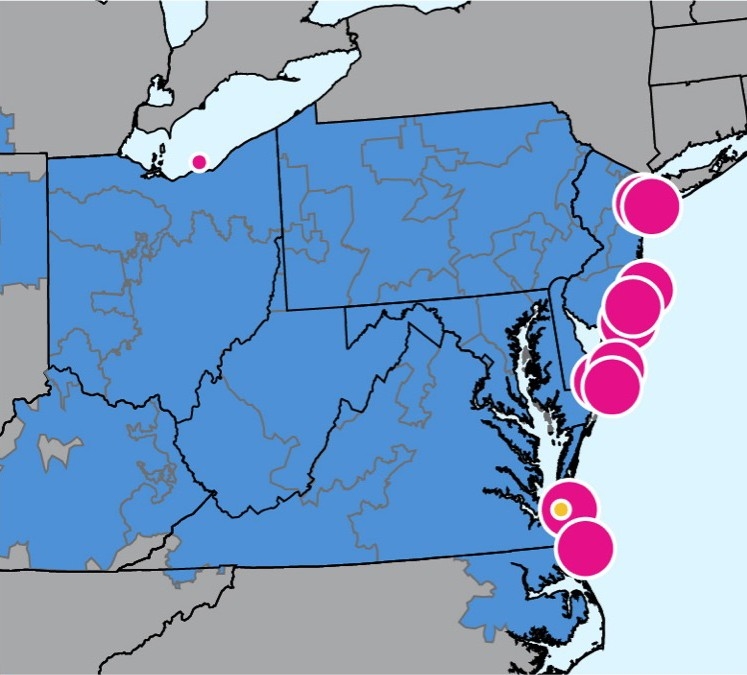
Long-term load
forecast adopts
Hourly Model
PJM’s long-term load forecast estimates electricity demand across the PJM region up to 15 years in advance. In 2022, PJM instituted key improvements to modeling and forecast inputs and processes to improve accuracy.
For example, for the long-term load forecast process released in late 2022, PJM used an hourly model rather than a daily model. This enabled PJM to better model the impacts of solar Behind the Meter Generation and Energy Storage Resources.
Forecast Highlights
The long-term load forecast accounts for possible growth of electric vehicles in the PJM footprint.
0.8%
per year for summer peaks
1%
for winter peaks
1.4%
for net energy over a 10-year planning horizon Starting in 2023
In a key change, PJM used monthly rather than annual economic and other government and private data to model residential, commercial and industrial sectors.
The forecast accounts for possible growth of electric vehicles in the PJM footprint.
500,000
IN 2022
5,000,000
IN 2038
Furthering long-term
Transmission
Planning
In its focus on long-term transmission planning, PJM was in step with growing interest by FERC, which issued the following four related Notices of Proposed Rulemaking (NOPR):
- Building for the Future Through Electric Regional Transmission Planning and Cost Allocation and Generator Interconnection (also called the Long-Term Planning NOPR)
- Transmission System Planning Performance Requirements for Extreme Weather
- One-Time Informational Reports on Extreme Weather Vulnerability Assessments, Climate Change, Extreme Weather and Electric System Reliability
- Improvements to Generator Interconnection Procedures and Agreements

In February, PJM kicked off a series of Long-Term Transmission Planning Reform Workshops to engage stakeholders on potential reforms. PJM filed its comments on FERC’s Long-Term Planning NOPR in August after significant feedback from stakeholders, state regulators and staff.
PJM executives also were busy providing testimony on the issue, including Ken Seiler, Vice President – Planning. Among his appearances, he joined FERC’s Oct. 6 Technical Conference on Transmission Planning and Cost Management, where he detailed how PJM evaluates, selects and develops regional transmission facilities.

Illinois climate and equitable jobs act
Reliability Guidance
and study
Keeping grid reliability as the first priority, PJM assists state policy makers with technical and planning expertise to further policy goals. In 2022, PJM expanded outreach and coordination with states to ensure that reliability remains paramount amid the evolving resource mix.
FOR ILLINOIS, PJM:
Published, in tandem with Illinois government,
that are subject to emission limitations and defined phase-out dates to allow for these generators to continue to run in order to preserve reliability.
Led a coordinated study with Midcontinent Independent System Operator (MISO) of Illinois energy policy to
for five transmission zones in response to the Illinois Climate and Equitable Jobs Act (CEJA)
examining system upgrades, which may be required between 2030 and 2045 – expected fossil resource deactivations of about 14,848 MW dispersed across the footprint will affect power flows and voltage stability.
with the MISO grid to ensure cost-effective interregional transmission solutions
PJM Studies inform the
Energy transition
In May, PJM released the second phase of its ongoing study to explore potential system impacts of the evolving resource mix, including the accelerating integration of renewables.
Five key focus areas
Energy Transition in PJM: Emerging Characteristics of a Decarbonizing Grid suggests five key focus areas for PJM and its stakeholders and informs subsequent phases of the study, outlined in the following findings:
Electrification
Electrification shifts the seasonal resource adequacy risk to winter.
Retail Rate Design
Retail rate design and energy storage become increasingly important with electrification.
Market reforms
Market reforms are needed to incent operational flexibility and mitigate uncertainty.
renewable resources
The integration of renewable resources increases the need for balancing resources to meet forecasted ramping requirements.
Energy storage
Energy storage (defined as four hours) enhances operational flexibility, but seasonal capacity and energy constraints require transmission expansion, long-term storage and other emerging technology.

In October 2022, PJM published an addendum to the study, developed in response to stakeholder questions and feedback.
DOWNLOAD the pdf
Also in 2022, PJM released a report outlining a vision for the grid of the future informed by examining how key industry trends and drivers could impact PJM and its transmission planning process.
DOWNLOAD Report
Grid of the Future: PJM’s Regional Planning Perspective envisions a transmission system driven by decarbonizaton, renewables, public policy, a diverse resource mix and new technologies.
DOWNLOAD the pdfPJM Leadership
perspectives
As the resource-neutral, FERC-designated grid operator of the largest bulk electric system in the U.S., PJM offers perspectives on operations, planning and markets and implications for the evolving system to the energy industry, stakeholders, policy makers and other entities.

PJM President & CEO Manu Asthana was appointed to the President’s National Infrastructure Advisory Council. The NIAC advises the White House on how to reduce physical and cyber risks and improve the security and resilience of the nation’s critical infrastructure sectors.
Since its establishment in 2001, the National Infrastructure Advisory Council (NIAC) has addressed issues including: improving intelligence information-sharing across government and industry; identifying and reducing complex cyber risks; and better preparing for and responding to disruptions that can ripple across multiple infrastructure systems.
It is the only executive council that examines critical infrastructure security and resilience and provides recommendations to the President.
The Chamber of Commerce for Greater Philadelphia appointed Asthana to its executive committee. Asthana’s appointment in October to the 32-member executive committee of the Chamber of Commerce continues his service on the organization’s board of directors, which began in 2020.

Stu Bresler III, Senior Vice President – Market Services, was appointed to the U.S. Department of Energy’s Nuclear Energy Advisory Committee (NEAC).
The NEAC functions under the Office of Nuclear Energy and plays a role in advising on issues, plans and priorities related to the agency’s nuclear programs.
Bresler joins 10 additional nuclear science, business, academic and energy industry leaders as members of the committee.

Ken Seiler, Vice President – Planning, was appointed to the ReliabilityFirst board of directors where he represents the Regional Transmission Organization (RTO) Industry Sector, a board position that rotates to a different RTO each term to ensure active and equal RTO representation and guidance.
ReliabilityFirst’s mission is to ensure that the electric grid is reliable and secure – not only for today but also for tomorrow.

Darlene Phillips, Executive Director – Operations Engineering Support, was reappointed to the U.S. Department of Energy’s Electricity Advisory Committee (EAC).
The EAC advises federal energy policymakers and regulators on grid resilience, security and reliability, and helps identify emerging issues and makes recommendations.
